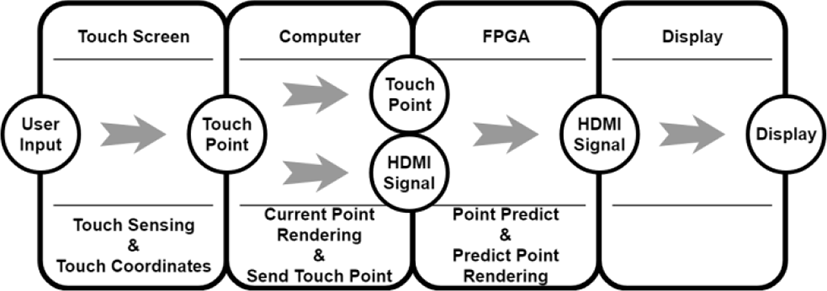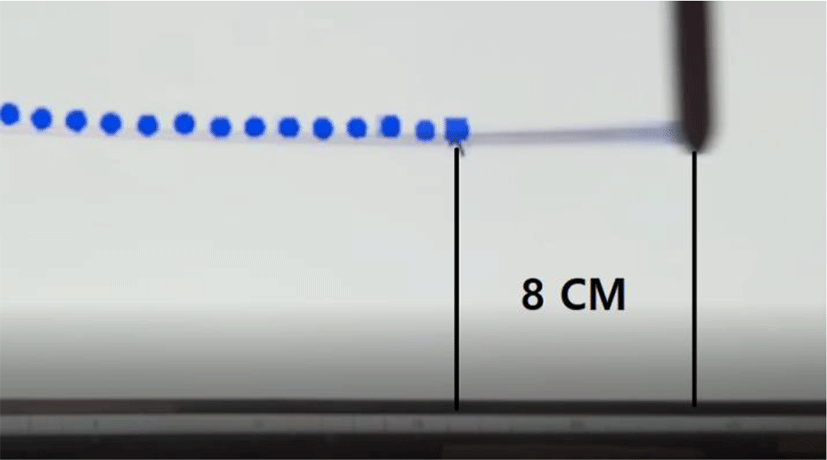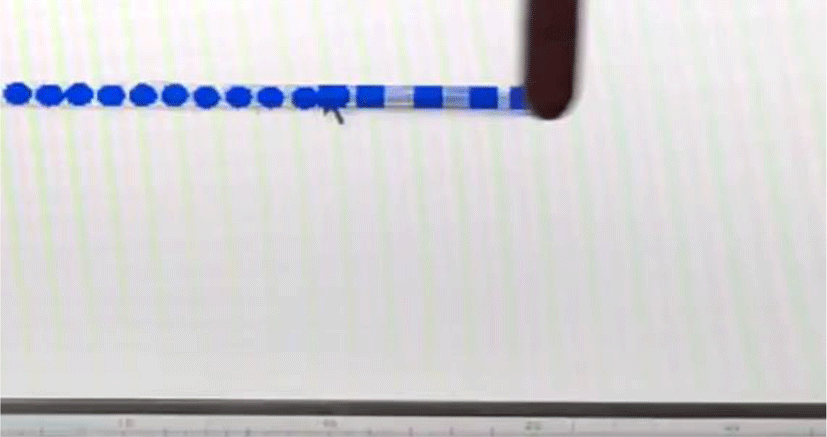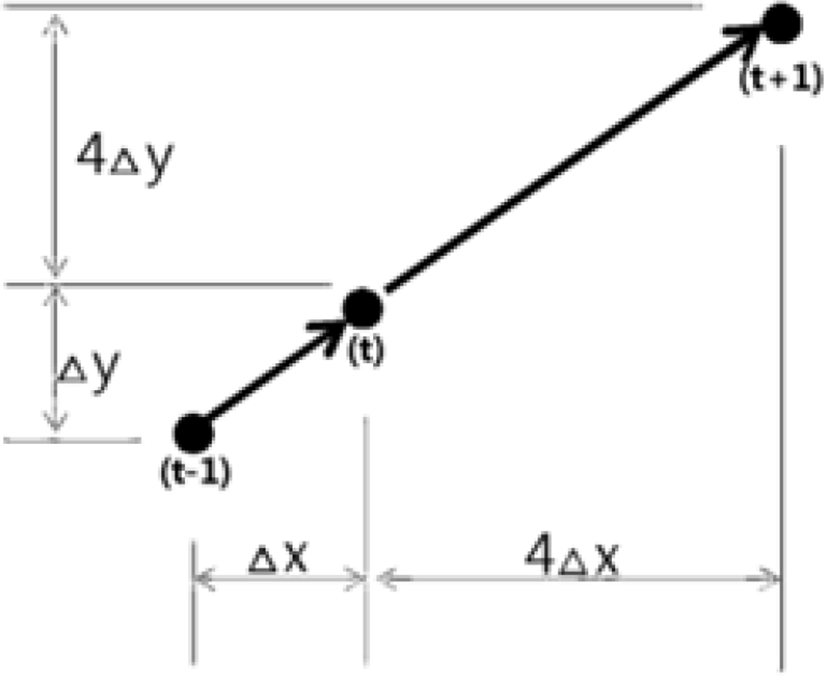I. INTRODUCTION
Touchscreens are a type of interactive system. Touchscreens have direct touch devices and indirect touch devices. Many direct-touch devices such as smart phones, tablets, PCs, etc. are already familiar Human Input Devices (HID) [8], since the user feels the more intuitively direct-touch device than the indirect-touch device [2]. All interactive systems have a delay between input action and feedback, which is called “latency” [5]. delay time is an important issue of interactive systems and must be solved [1]. In the case of a dragging action which is one of the touch actions, the user responds most sensitively to the latency. When the user dragging with the direct-touch device, it is difficult to perceive the latency when the latency is 11ms or less. When the latency is 2.38ms or less, the latency is not perceive [3]. However, the recent direct-touchscreen device has a latency of 50ms to 200ms, so the latency appears visibly [4]. Latency in a direct-touch device has many sources, usually with three main components: 1) the physical sensor that captures touch points; 2) the software that processes touch events and render feedback; 3) the display itself [5]. Software feedback requires the most latency among the three components. Many methods have been studied for predicting touch points as a method for reducing the latency of software feedback [6].
We propose to change touch point prediction feedback rendering using conventional software rendering to hardware rendering using FPGA. In general, touch points prediction is not perfect. When using point prediction, feedback of the predicted points is displayed on the screen, after a while, erased when the actual points are displayed. When this task is implemented by software, it causes additional latency to work to erase predicted points feedback. When the FPGA modifies the HDMI signal directly, the rendering time is reduced and the predicted rendering is removed automatically when the next frame is displayed [7]. Because the OS uses the frame buffer on the memory to display the screen. However, the FPGA does not use memory to directly modify HDMI. Therefore, unless we modify the HDMI signal with the FPGA when outputting the next frame and displaying it on the OS, the previously rendered data disappears. Hence, this method works because hardware rendering does not cause additional latency when displaying feedback of predicted touch points.
II. RELATED WORK
There are many studies to numerically express the effect of touch latency. In these studies, it is possible to know the side-effects of touch latency on users and delay time with effective performance [3,5,10,12]. For each touch action such as tapping and dragging, the latency that the user perceives as reliable is different. Among them, in the case of dragging that responds most sensitively to the user, if it is 11ms or less, it shows high reliability and does not perceive latency when it is 2.38ms or less [5].
Touch coordinate prediction techniques are described in many papers and patents [9,10,11,22]. For example, Taylor series, Kalman filter, Curve fitting, Heuristic, linear short-term, and Quadratic are examples of typical points prediction algorithms [11,13,14]. All prediction algorithms have less accuracy as the prediction distance increases. Hence, the setting of the predicted distance should be carefully considered [14].
Hardware rendering transmits rendering information such as touch coordinate information, color, size, and HDMI signals to the board equipped with the FPGA is mounted. The transmitted touch point and rendering data directly modifies the HDMI signal through the pipeline structure [15] and outputs it to the display device. The method of modifying the HDMI signal calculates the pixel range of the coordinates to be changed by using the information of the input touch point and size. Then, when it is within the changed pixel range as compared with the currently updated pixel position, the color of the pixel is changed to the color of the touch pen with the color of the original image. This method has a latency of less than 1ms with parallel processing using hardware. It is more effective for embedded systems with less delay time than software feedback rendering and without a graphics processing unit (GPU) [7].
III. SYSTEM CONFIGURATION
Figure 1 shows the process of displaying the user's touch input to the display. The conventional touch interactive system is as follows. 1) It senses the touch on the touchscreen, coordinates the touch points, and sends it to the computer. 2) The computer renders feedback of received points.
We added hardware predictive rendering to the existing software touch rendering system. In order to perform hardware prediction rendering, first, HDMI signals and rendering information such as touch point, color, size, etc. are transmitted to the board equipped with the FPGA. The feedback of the points predicted based on the received points directly modifies the HDMI signal.
The hardware of the platform is composed of AFO 65inch large touchscreen [19], Raspberry Pi 3 Model B Computer by Raspberry Pi Foundation [18], Digilent’s Nexys Video Board [17] with Xilinx’s Artix-7 xc7A200T-1SBG484C FPGA [16], and Samsung’s 65inch LED Display [21].
IV. EXPERIMENT
We execute the touch rendering-software in an environment where Raspbian OS is installed in Rasspberry Pi 3 Model B. This software is a touch rendering software that uses the Qt graphics framework [20] and requires a 2ms latency when rendering a 10 x 10 pixel point. It is a very simple program to render touch point feedback and send points, rendering time is short. Commercial programs support a lot of work including inking work, so the rendering latency is much longer. The touchscreen requires a total 5ms latency in touch points coordinates and transmission [19]. So the total rendering time is 7ms. When prediction algorithms are implemented in software, an additional latency of 4ms occurs for each prediction point. In order to visually confirm the touch latency, we shot at 240 frames per second (FPS) using iPhone X's slow motion movie shooting function [23]. Touch points prediction uses a linear short-term algorithm that is simple to implement and has effective performance [14].
Figure 2 shows only software rendering without hardware prediction rendering. We can perceive the difference between actual touch point and rendered feedback.
Figure 3 shows a combination of software rendering and hardware prediction rendering. The predicted points are five. When rendering this work in software, additional memory is required and the latency is increased by 20ms. However, regardless of the number of points, hardware rendering has latency of 0.74ms and does not require additional memory [7]. In Figure 2, the distance between the feedback and the actual touch point is noticeable. However, in Figure 3, it appears that there is almost no distance between the actual touch point and the feedback. This is because the touch points were predicted and rendered.
Figure. 4 is a diagram representing a method of predicting touch point. In the two-dimensional plane, let the previous touch point be t-1 and the current touch point be t. It is possible to know the amount of change in the X point and the amount of change in the Y point via the previous touch point and the current touch point. This change amount can be applied to the current point to calculate the predicted point t + 1. Through this experiment, we can see that predictive rendering of touchpoints is visually effective.
Table 1 shows the total latency difference between software prediction line rendering and hardware prediction line rendering due to touchscreen latency. The latency of each experiment is including latency of software touch line rendering. The vertical axis is the sum of rendering times excluding the touchscreen latency. This experiment generates virtual touch events that drag 1200 pixels per second. After 200 experiments, we measured the average of the latency required each time a touch event was generated. Hardware prediction line rendering is not yet implemented. However, since hardware rendering always requires the same latency regardless of the amount of rendering, we can assume that the hardware predicted line rendering latency is 1ms. In Table 1, we can see that the longer latency of the touchscreen, the greater the latency difference between hardware predictive rendering and software predicted rendering when performing predictive rendering. As the latency of the touchscreen increases, the distance between points also increases, so the prediction distance also increases. As the prediction distance increases, the amount of rendering increases, so hardware prediction is less latency than software prediction.
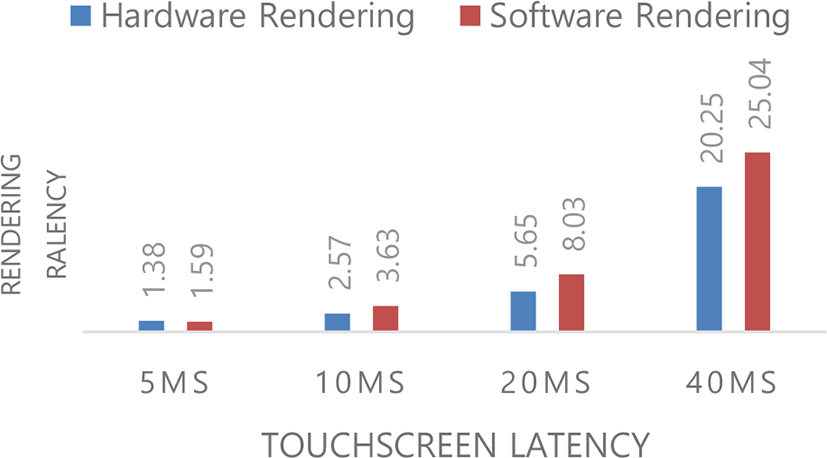
|
V. CONCLUSION
Comparing Figure 2 and Figure 3, we can see that the difference between the two pictures is clear and prediction rendering is effective. Table 1 shows that hardware prediction rendering requires less latency than software prediction rendering. Hence, Hardware predictive rendering using FPGA is effective in reducing latency. Hardware rendering always requires the same latency regardless of graphics processing speed. Hence, It is better to apply it to an embedded system with low graphics processing speed.
We plan to study more precise touch points prediction algorithm, multi-touch prediction, hardware implementation of prediction algorithm, and hardware line rendering.
